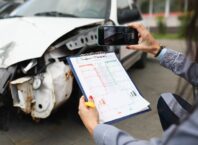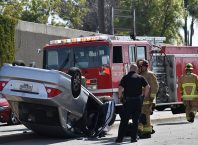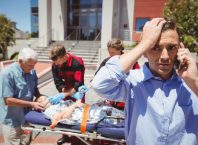According to the National Highway Traffic Safety Administration (NHTSA), motorcyclists are 27 times more likely than passenger vehicle occupants to die in a crash, and 4,985 motorcyclists were killed in traffic accidents in 2018. While these statistics aren’t great, there are things you can do to reduce your chances of having an accident.
Being involved in an accident can be a stressful experience, and sometimes it can be difficult to know what to do or where to begin. Do you need to take photos? Should you see a doctor? Should you consult a personal injury attorney? Below are some common causes of motorcycle accidents, things you can do to reduce your risk, and five steps to follow if you do have an accident.
Contents
Common Causes of Motorcycle Accidents
- Unsafe Lane Changes – The size of motorcycles makes them appear small enough to be blocked by a glare or other vehicles or to be hidden in other motorists’ blind spots, resulting in other drivers not being able to see them. This can cause problems if other drivers change lanes or make turns without checking their blind spots first. They may not yield the right-of-way because they can’t see approaching motorcycles.
- Lack of Experience – According to NHTSA data, one of the top causes of motorcycle accidents is lack of experience. An inexperienced rider may not understand the limitations and operating characteristics of a motorcycle. Motorcycle riders must be skilled in defensive driving techniques, aware of weather or road conditions, and visible at all times.
- Lane Splitting – Lane Splitting occurs when motorcycle riders ride between two lanes or pass other vehicles going in the same direction within the same lane. While lane splitting is legal in California, it is illegal in every other state in the country. According to the California DMV’s website, “California law does not allow or prohibit motorcycles from passing other vehicles proceeding in the same direction within the same lane.”
- Left Turns – Many motorcycle accidents involve left turns. Other drivers may not see the motorcycle’s turn signal, or they may turn into the motorcycle while making a left turn.
- High Speed or Recklessness – Accidents can occur when people drive aggressively, travel at high rates of speed, or tailgate other vehicles.
- Alcohol Use – Alcohol use can impair drivers, which can lead to accidents.
- Poor Road Conditions – Loose gravel, wet or slippery roads, uneven pavement surfaces, or debris can create hazardous road conditions that can contribute to accidents.
- Car Doors – Accidents can happen when motorists in their parked cars open their car doors into the paths of motorcycle riders, who then run into these open doors.
Safety Measures
Wear Protective Gear
You should always wear a helmet and protective eye wear or a face shield. Wearing a helmet may protect you from serious head injuries. According to the CDC, wearing helmets can reduce the risk of sustaining a head injury in a motorcycle accident by 69% and the risk of death by 37%.
Wearing protective garments, such as leather clothing and gloves can help minimize injuries you may sustain during an accident.
Be a Defensive Rider
Riding a motorcycle requires greater coordination and a different skill set than driving a car, so make sure you are properly trained before you ride. Don’t assume that drivers of cars or trucks can see you. To increase your visibility, stay out of other drivers’ blind spots, and keep your headlights on. You should also follow traffic rules and posted speed limits.
Stay Alert and Sober
Don’t ride if you are drowsy or if you have been drinking. Depending on your weight, metabolism, gender, and how much food you have eaten, you may begin to show signs of impairment after only a couple of drinks, even if you have not reached the legal limit. Alcohol consumption can slow your response time and make riding dangerous.
Take Care of Motorcycle Maintenance
Make sure your motorcycle is properly maintained. Check your tires for signs of excessive wear, and make sure the air pressure is correct. Check your fluid levels, and make sure your headlight, taillight, and turn signals are working properly. Taking a few minutes to do this may help you prevent potential problems.
What if You’re Involved in a Motorcycle Accident? – 5 Steps to Take
Step 1: Report the Accident to Police
If you are in an accident, call 911 and report it immediately. Most states have laws requiring you to report accidents immediately, and if you leave the scene of the accident without reporting it, you could be committing a crime in some states. If you or anyone else is injured, you should be checked out by a medical professional.
Step 2: Collect Information
Unless you are incapacitated, get contact information for anyone involved in the accident, as well as any witnesses. It is important that you not say anything that could be construed as an admission of fault, even if you feel the accident is your fault. As part of the information collecting process, take photos of your motorcycle, any other vehicles involved in the accident, and the street, intersection, or location where the accident occurred. If you are unable to take photos, ask somebody else to do it for you.
Step 3: See Your Doctor
Even if you don’t require hospitalization, you should still see your doctor. Your doctor may find evidence of injuries that may not be immediately obvious to you, and you may not be aware of some injuries until hours after the accident or even the next day.
Step 4: Call Your Insurance Company
Notify your insurance company of your accident by calling the “Claims” number on your insurance card or policy. Your representative will help you proceed with your insurance claim.
Step 5: Contact an Attorney
A personal injury attorney can explain your legal rights and potential liabilities as they pertain to your accident. Your attorney can help you determine how to best handle your case.
By understanding the common causes of motorcycle accidents and taking safety precautions, you can reduce your risk of having an accident. And if you do have an accident, following these steps can get you on your way to recovering from it, both physically and financially.












